“THE POWER DRUG”
An in-depth analysis of
Stanley Kubrick’s
A CLOCKWORK ORANGE
Text copyright © by Rob Ager 2010
CHAPTER FOUR
THE NEW PSYCHEDELIC FASCISM
THE NEW PSYCHEDELIC FASCISM
Kubrick rarely engaged in published exchanges with his critics. His silence alone tended to render his detractors as irrelevant. For the most part he kept this up even during the controversy over ACO, where as most film makers would be out shouting about the merits of their work and the nobility of their intentions.
However, there was a notable exception. The heavyweight political writer Fred M. Hechinger wrote an attack on Kubrick’s ACO, claiming that the film supports fascism. The full article by Hechinger can be read at this link (scroll to the bottom portion of the linked page) on the excellent Kubrick Site. Personally, I found the article to be typically vague political rhetoric – high on ideological posing and almost completely lacking in supporting evidence.
However, people often rate arguments based upon who is speaking rather than what is being said. Probably being well aware of this, Kubrick took Hechinger on publicly like a chess opponent. His lengthy response letter, published in the New York Times in 1972, puts Hechinger’s arguments succinctly into the context they deserve. He cites Hechinger’s second hand writing approach(his regurgitation of other journalists’ work without any original research or direct reference to the source film content), his“alarmist” opposition to artists’ free speech and promotion of censorship, and examples of other respected journalists’ and political writers who had written articles completely at odds with Hechinger’s assertions. In citing such a variety of literary sources Kubrick further revealed his own fascination with philosophy, politics and social sciences. Kubrick’s full response can also be read at the above link to the Hechinger article and was published again in the Stanley Kubrick Archives book.
Getting back to our task here, there is a particular section of Kubrick’s response to Hechinger in which the director explicitly reveals one of ACO’s social themes.
Hechinger is probably quite sincere in what he feels. But what the witness feels, as the judge said, is not evidence -- the more so when the charge is one of purveying "the essence of fascism.""Is this an uncharitable reading of...the film's thesis?" Mr. Hechinger asks himself with unwonted if momentary doubt. I would reply that it is an irrelevant reading of the thesis, in fact an insensitive and inverted reading of the thesis, which, so far from advocating that fascism be given a second chance, warns against the new psychedelic fascism -- the eye-popping, multimedia, quadrasonic, drug-oriented conditioning of human beings by other beings -- which many believe will usher in the forfeiture of human citizenship and the beginning of zombiedom.
ACO is, in part, a warning against the hedonistic dumbing down of society or, in Kubrick’s words, “the new psychedelic fascism”. Undoubtedly, this theme contributed to Kubrick’s aesthetic choices in set and prop design. The resulting variety of sexually surreal“art” in the film doesn’t feature in Burgess’ book.
First up we have the most obvious examples, spanning across three scenes. There’re the fibre-glass naked women, moulded in sexually subservient positions, in the Korova Milk bar.
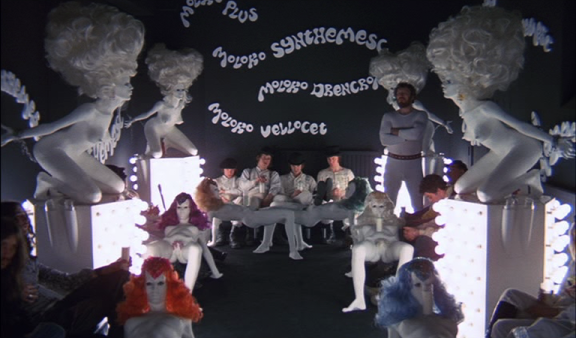
There’s the, verging on pornography, painting of a naked woman in Alex’s bedroom. Note the phalic branch sticking from the wall. It is positioned as if penetrating the woman in the painting. In a later shot Alex's snake is coiled around this branch and sniffs at the genitalia of the woman in the painting.
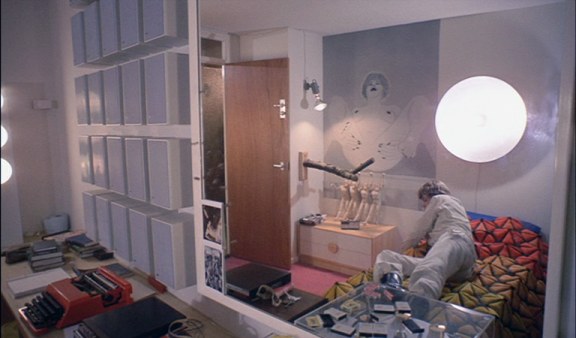
And there’s the Cat-lady’s collection of pornographic paintings and her phallic sculpture.
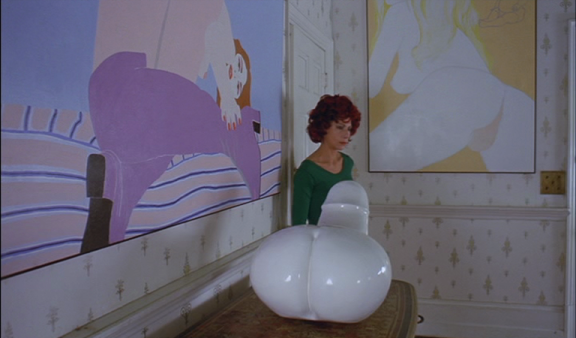
These art-porn features are another variation on the hypocrisy themes.
In the Cat-lady’s gym, our first close up view of the phallic sculpture is placed directly beneath a painting of a naked woman (see screenshot above). The composition reveals an interesting parallel. The testicles at the back of the sculpture are shaped like the buttocks of the woman in the painting. The woman and sculpture are both painted plain white and the woman has her back arched upward, just as the phallic end of the sculpture is arched upward. The sculpture is a fusion of the female figure and male genitalia.
One of the Cat-lady’s more surreal paintings features a woman masturbating as she holds in her free hand a small man in a white suit, black hat and white boots. The man appears to be dressed in the same outfit as Alex and his droogs.

The implication here is that Mrs Weathers, the Cat-lady, has a sexual nature identical to Alex’s. Her penis sculpture, which she angrily claims to be “a very important work of art” represents a reversal of sexual dominance – a naked woman as a large, imposing, erect penis. This all parallels directly with the pornographic art and Dancing Jesus sculptures featured in Alex’s own bedroom.
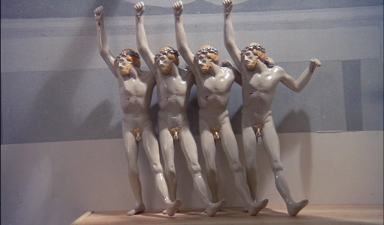
The Jesus figures are called Christ Unlimited and were designed by Herman Makkink.
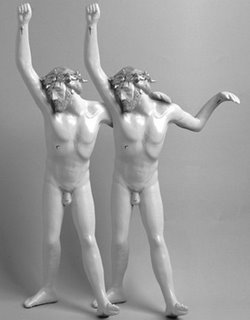
Note that they don't necessarily come as a set of four - many can be linked together in a chain. Kubrick's choice of four Christ Unlimited figures for the scene parallels the four droogs of Alex's gang. These Christ droogs each hold one hand up above them, much like the masturbating lady in Mrs Weather’s painting. The figures symbolically come to life in a series of close up shots, as if dancing just as Alex and his droogs did when attacking the writer and his wife.
Mrs Weathers, in her leg stretching aerobic position, imitates the sexually dominant women in her own paintings (note that the painting of a woman in purple boots appears to be doing some sort of stretching exercize combined with sexual exhibitionism on a mattress).

When Alex hits Mrs Weather with the sculpture she is in a similar exercize position as she was at the beginning of the scene. The violence from Alex is even inter-cut with several flash frames of her paintings.
Another painting in the Cat-lady’s gym shows a woman with the breasts cut out of her clothing and a sash around her mouth. This is a repeat image of the writer’s wife, prior to being raped by the droogs, who incidentally was stood by a painting.

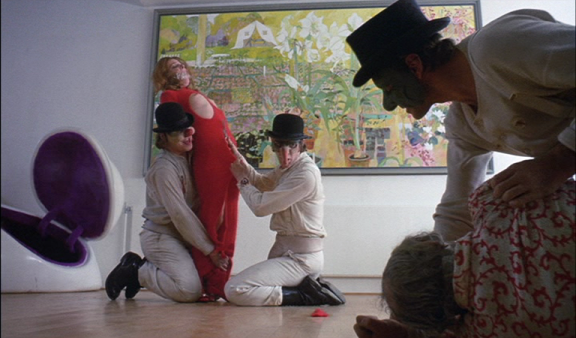
Broadly, the art work in the Cat-lady's gym communicates a simple theme – the Cat-lady shares Alex’s sexual dominance fantasies and both characters consider their expression of such impulses to be a form of art.
At a more subtle level, we even find an indulgence of pornography from Alex’s parents, one that is paralleled in the Cat-lady’s house. After returning from prison, Alex enters the apartment. On either side of him are two paintings of alluring women by J.H. Lynch and in the living room are two more mildly erotic paintings by the same artist.
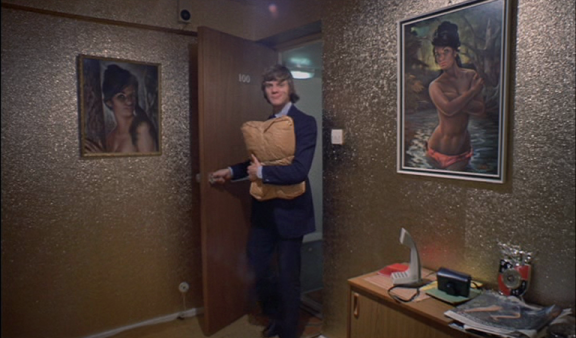
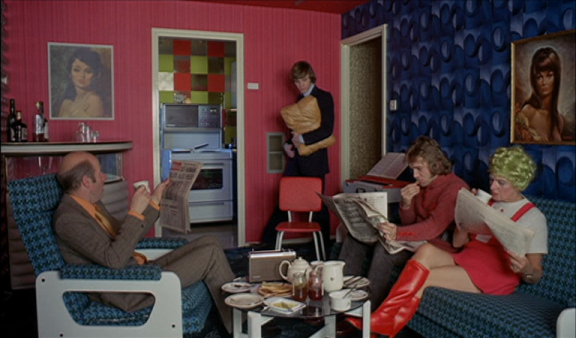
The picture right screen, as Alex enters the apartment, is called “Nymph” and beneath is a phallic shaped telephone aimed in the painting’s direction, next to a mildly erotic picture of a woman in a magazine (the phone prop certainly isn’t accidental, as we’ll discover in a later chapter). The “Nymph” is stood in thigh deep water, as is a naked woman in the painting directly above Mrs Weathers’ telephone. Although the Cat-lady's phone isn’t phallic shaped, a bust of Beethoven stands erect beneath the painting instead. The Cat-lady uses this phallic ornament to attack Alex, to which he responds by hitting her back with a more obvious phallic ornament.


These symbols demonstrate that sexual exhibitionism isn’t unique to young thugs such as Alex. The celebration of sexual impulses is a wider social phenomena that crosses class and age boundaries.
This masquerading of hardcore pornography as art is revealed more bluntly as Alex listens to Beethoven in his bedroom. He sits staring at the Dancing Jesus figures and a painting of a naked woman with her legs spread wide open, his face flushed, his eyes popping out and a slow back and forth movement of his left shoulder. It doesn’t take much imagination to realize what Alex is doing. This innuendo was also present in Burgess, book …
As I slooshied, my glazzies tight shut to shut in the bliss that was better than any synthemesc Bog or God, I knew such lovely pictures. There were vecks and ptitsas, both young and starry, lying on the ground screaming for mercy, and I was smecking all over my rot and grinding my boot in their litsos. And there were devotchkas ripped and creeching against walls and I plunging like a shlaga into them, and indeed when the music, which was one movement only, rose to the top of its big highest tower, then, laying there on my bed with my glazzies tight shut and rookers behind my Gulliver, I broke and spattered and cried aaaaaaah with the bliss of it. And so the lovely music glided to its glowing close.
… but is taken further by Kubrick with a series of symbolic images that Freud or Hitchcock would have been proud of.
- A woman being hung from a gallows (this is a stock shot from the film Cat Ballou)
- An explosion of Earth
- A moving train exploding
- Alex as a vampire
- Cavemen being crushed by rocks from an erupting volcano (this shot is taken from the 1966 film One Million Years B.C. and can be seen in this trailer).
- An eruption of hot lava
The fusion of art and pornography has certainly reached and surpassed ACO’s warnings in the real world. Today thousands of MTV videos bombard adults and children with images of near naked men and women, flaunting their sexuality and rubbing their bodies together in competing gestures of sexual dominance. Pre-pubescant girls imitate these dress fashions and dance routines, while singing lyrics laced with erotic innuendos. The production and distribution of pornography is a massive industry that gets little mention in the press, perhaps because even tabloid newspapers are getting in on the act by incorporating soft porn into their pages.
We have been immersed in this new tasteless society for decades. Intellect and morality are devalued in favour of hedonism and sexual ego. In ACO, as in our world today, the tasteless indulgence extends into fashion, décor and architecture. Women, including Alex’s mother and the psychiatrist who quizzes Alex in hospital, dress and die their hair in over-bearing and mismatching colours. The bootik, where Alex goes to buy records, is disorientating in its use of ceiling mirrors and floor to ceiling racks of pop imagery. The bootik location wasn’t even designed by Kubrick, it was a real location called The Chelsea Drugstore. Here is an excellent breakdown of props in the bootik scene by John Coulhart (we’ll return to Coulhart’s observations later). Perhaps Kubrick’s choice of this location wasn’t just about the look of the place, but also its name. Remember Kubrick’s description of “the new psychedelic fascism -- the eye-popping, multimedia, quadrasonic, drug-oriented conditioning of human beings by other beings”? Hedonistic art and music have become psychological drugs. The number one record listed in the top ten chart in the bootik is called Mass in G by Goggly Gogol.
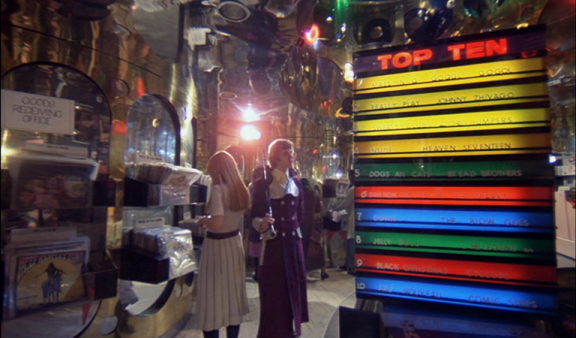
Mass in G may refer to a classical piece by Vaughan Williams, and may be Kubrick’s comment on how cheap, modern pop music has converted real music into assembly line imitation. Although we’re led to believe Alex has no interest in this music, this is the very same musical piece that he pulls from his cassette player before inserting his Beethoven tape.
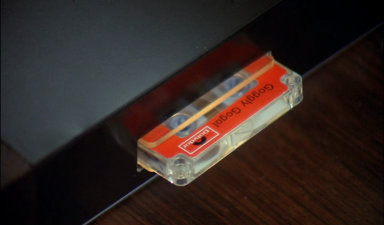
Kubrick was also able to handpick real world examples of tasteless architecture – several of which are still standing today and are explored in this link at the Worldwide Guide to Movie Locations website.
The age of eye-popping psychedelia has been upon us for decades and it can certainly be argued that new technology and cheap forms of media distribution are the cause of it, but Kubrick’s description of a New Psychedelic Fascism is a harsher view. Rather than describing the use of such psychedelia as some sort techno-political conspiracy to dumb down the masses, Kubrick may have simply been referring to the mass distraction effect of such media, which draws the attention of citizens away from the activities of potentially fascist governments – thus facilitating the gradual re-emergence of fascism.





















